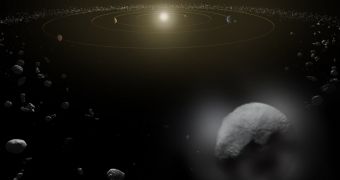A group of investigators from the ESA European Space Astronomy Center, in Spain, recently used the European Space Agency's Herschel Space Observatory to unambiguously detect the first-ever signs of water vapors around an object in the Inner Asteroid Belt, namely the dwarf planet Ceres.
The finding is very important because it sheds further light on the range of conditions in which water can exit in the Universe, regardless of its form. The dwarf planet Ceres is the target of the NASA Dawn mission, which is scheduled to enter orbit around the celestial body in less than two years.
This object is the largest in the IAB – larger than the super-asteroid Vesta – and boasts a diameter of around 950 kilometers (590 miles). Due to its larger size, Ceres is almost spherical, but not entirely so, most likely due to the fact that its formation process was interrupted sometime in the early history of the solar system.
Without this disruption, the causes of which have yet to be accurately pinpointed by astronomers, both Ceres and Vesta may have grown into Mars- or even Earth-sized planets. The dwarf planet now belongs in the same class as Pluto, Haumea, Makemake, and other bodies beyond the orbit of Neptune.
According to some researchers, Ceres may feature a layered interior, containing a core, a mantle, and the crust. In its particular case, the outer mantle may substitute the crust, and be made out of ice. Finding out whether or not this is the case has implications for understanding the evolution of our solar system.
The presence of water vapors in the areas immediately around Ceres was confirmed using the Heterodyne Instrument for the Far Infrared (HIFI) instrument on Herschel. The research team was also able to determine that the vapors were being released by the dwarf planet's surface.
“This is the first time that water has been detected in the asteroid belt, and provides proof that Ceres has an icy surface and an atmosphere,” ESAC investigator Michael Küppers says. He is the lead author of a paper detailing the findings, published in the January 22 issue of the top scientific journal Nature.
“We estimate that approximately 6 kg of water vapour is being produced per second, requiring only a tiny fraction of Ceres to be covered by water ice, which links nicely to the two localised surface features we have observed,” adds the principal investigator of the Herschel asteroid and comet observation program MACH-11, Laurence O’Rourke.

 14 DAY TRIAL //
14 DAY TRIAL //